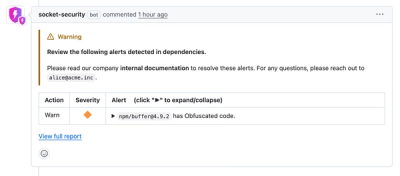
Security News
Crates.io Users Targeted by Phishing Emails
The Rust Security Response WG is warning of phishing emails from rustfoundation.dev targeting crates.io users.
@acdlite/router
Advanced tools
An experiment in functional routing for JavaScript applications.
npm install --save @acdlite/router
The name is intentionally generic because it's still in the experimental phase (perhaps forever).
Key features:
See below for a proof-of-concept that mimics the React Router API.
No.
Well, maybe. I'm currently using this in a side project, but I wouldn't recommend it for any production apps.
A "router" in the context of this project is a function that accepts a path and a callback. The router turns the path into a state object by passing it through a series of middleware. Once the middleware completes, the callback is called (either synchronously or asynchronously) with the final state object, which can be used to render an app.
History management is considered a separate concern — just pass the router a string. On the client, use a project like history. On the server, use your favorite web framework like Express or Koa.
const router = createRouter(...middlewares)
router('/some/path', (error, state) => {
// Render app using state
})
A middleware is a function that accepts Node-style callback (we'll call it a listener) and returns a new Node-style callback with augmented behavior.
type Listener = (error: Error, state: Object) => void
type Middleware = (next: Listener) => Listener
An important feature of middleware is that they are composable:
// Middlewares 1, 2, and 3 will run in sequence from left to right
const combinedMiddleware = compose(middleware1, middleware2, middlware3)
Router middleware is much like middleware in Redux. It is used to augment a state object as it passes through a router. Here's an example of a middleware that adds a query field:
import queryString from 'query-string'
const parseQuery = next => (error, state) => {
if (error) return next(error)
next(null, {
...state,
query: queryString.parse(state.search)
})
}
As with React props and Redux state, we treat router state as immutable.
All state objects should have the fields path, pathname, search, and hash. When you pass a path string to a router function, the remaining fields are extracted from the path. The reverse also works: if instead of a path string you pass an initial state object to a router function with pathname, search, and hash, a path field is added. This allows middleware to depend on those fields without having to do their own parsing.
There are two additional fields which have special meanings: redirect and done. redirect is self-explanatory: a middleware should skip any state object with a redirect field by passing it to the next middleware. Similarly, a state object with done: true indicates that a previous middleware has already handled it, and it needs no further processing by remaining middleware. (There are some circumstances where it may be appropriate for a middleware to process a done state object.)
Handling all these special cases can get tedious. The handle() allows you to create a middleware that handles specific cases. It's a bit like a switch statement, or pattern matching. Example
import { handle } from '@acdlite/router'
const middleware = handle({
// Handle error
error: next => (error, state) => {...}
// Handle redirect
redirect: next => (error, state) => {...}
// Handle done
done: next => (error, state) => {...}
// Handle all other cases
next: next => (error, state) => {...}
})
next() is the most common handler.
If a handler is omitted, the default behavior is to pass the state object through to the next middleware, unchanged.
As a proof-of-concept, the react-router/ directory includes utilities for implementing a React Router-like API using middleware. It supports:
config.getChildRoutes()config.getComponent()Not yet completed:
<Redirect> routesInternally, it uses several of React Router's methods, so the route matching behavior should be identical.
Example:
import { createRouter } from '@acdlite/router'
import { nestedRoute, getComponents, Route, IndexRoute } from '@acdlite/router/react-router'
import createHistory from 'history/lib/createBrowserHistory'
const reactRouter = createRouter(
nestedRoute(
<Route path="/" component={App}>
<Route path="post">
<IndexRoute component={PostIndex} />
<Route path=":id" component={Post} />
</Route>
</Route>
),
getComponents,
// ... add additional middleware, if desired
)
const history = createHistory()
// Listen for location updates
history.listen(location => {
// E.g. after navigating to '/post/123'
// Routers can accept either a path string or an object with `pathname`,
// `query`, and `search`, so we can pass the location object directly.
reactRouter(location, {
// Route was successful
done: (error, state) => {
// Returns a state object with info about the matched routes
expect(state).to.eql({
params: { id: '123' },
routes: [...] // Array of matching route config objects
components: [App, Post], // Array of matching components
// ...plus other fields from the location object
})
// Render your app using state...
},
// Handle redirects
redirect: (error, state) => {
history.replace(state.redirect)
},
// Handle errors
error: error => {
throw error
}
}
})
A key thing to note is that the server-side API is exactly the same: instead of using history, just pass a path string directly to the router, and implement done(), redirect() and error() as appropriate.
Also note that there's no interdependency between history and your routing logic.
The router returns the matched components, but it's up to you to render them how you like. An easy way to start is using Recompose's nest() function:
const Component = nest(...state.components)
ReactDOM.render(<Component {...state.params} {...state.query} />)
That gets you 90% of the way to parity with React Router. Conveniences like the <Link> component and transition hooks would need to be re-implemented, but are fairly straightforward.
FAQs
An experiment in functional routing.
The npm package @acdlite/router receives a total of 0 weekly downloads. As such, @acdlite/router popularity was classified as not popular.
We found that @acdlite/router demonstrated a not healthy version release cadence and project activity because the last version was released a year ago. It has 1 open source maintainer collaborating on the project.
Did you know?

Socket for GitHub automatically highlights issues in each pull request and monitors the health of all your open source dependencies. Discover the contents of your packages and block harmful activity before you install or update your dependencies.

Security News
The Rust Security Response WG is warning of phishing emails from rustfoundation.dev targeting crates.io users.

Product
Socket now lets you customize pull request alert headers, helping security teams share clear guidance right in PRs to speed reviews and reduce back-and-forth.

Product
Socket's Rust support is moving to Beta: all users can scan Cargo projects and generate SBOMs, including Cargo.toml-only crates, with Rust-aware supply chain checks.